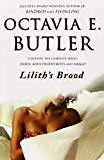
The first novel in the trilogy, Dawn, was published in 1987. The story begins after the United States and the Soviet Union obtained nuclear weapons and their actions resulted in a terrible nuclear war that left the earth uninhabitable. Humans are all but extinct. The few survivors are plucked from the surface of their dying world by an alien race, the Oankali. The title character Lilith (a black human female) awakens centuries later from stasis on an Oankali ship. She meets her saviors/captors and is repulsed by their alienness. The Oankali don’t have eyes, or ears, or noses, but sensory tentacles over their entire bodies with which they can perceive the world much better than a human can. Stranger still, the Oankali have three sexes: male, female, and Ooloi. All Oankali have the ability to perceive biochemistry down to a genetic level,but the Ooloi have the ability to directly manipulate genetic material.
Ooloi can mutate and“evolve” any living thing they touch and build offspring gene by gene using the genetic material from their male and female mates. Despite their differences the Ooloi Oankali are strangely alluring, sexually arousing even while being visually repulsive. The Oankali have made earth habitable andwant Lilith's help in training humans to survive on earth without human technology. In exchange the Oankali want to interbreed with the humans to create a new human-Oankali hybrid race. They are particularly enthusiastic about the human "talent" for cancer, which they find beautiful. This book focuses on the conflict between Lilith's desire to stay human and her loyalty to her species and her desire to survive at any cost.
The second book, Adulthood Rites , published in 1988, takes place years after the end of Dawn . Humans and Oankali live together on earth though everything is not peaceful. Some humans have accepted the bargain and live with the Oankali and give birth to hybrid children called 'constructs.' Others, however, have refused the bargain and live in separate, all human, Resister villages. The Ooloi have made all humans infertile so the only children born are the ones made with Ooloi intervention. This creates a great deal of tension and strain as the humans see their lives as meaningless without children, as well as seeing themselves being outbred by the Oankali-human constructs. Desperate humans often steal human looking construct children to raise as their own. The main character of the second book, Akin, is the first male construct born to a human mother (Lilith). Akin has more human in him than any construct before him. This book focuses on Akin’s struggle with his human and his Oankali natures.
As a human he understands the desire to fight for the survival of humanity as an independent race. As an Oankali he understands that the combination of the species is necessary and that humans would destroy themselves again if left alone. Akin is kidnapped by the resisters as an infant, when the only evidence of his construct status is a tentacle-like tongue through which he samples his world in the Oankali manner of identifying DNA. The Oankali allow the resisters to keep him for a sustained period of time so that he might understand his human nature more fully, but at the cost of the connection to his paired sibling that would have happened had he stayed with his family. His isolation is hugely painful to them both, and he is taken to the orbiting ship to experience whatever healing he and his not-sufficiently-paired sibling can be granted.
During that time, he travels around the ship with an Akjai, an Oankali who has no human DNA. Through these experiences, he realizes that humans, too, need an Akjai group, and his conviction ultimately persuades the Oankali. Humans will be given Mars, modified sufficiently to (barely) support human existence, despite the Oankali certainty that the Mars colony will destroy itself eventually. Akin returns to tell the resisters and begin gathering them up to have their fertility restored before transport to their new world.
The final book of the trilogy, Imago published in 1989, is the shortest. Imago shows the reader what has been hinted at for the last two books, the full potential of the new human-Oankali hybrid species. The story is told from the prospective of Jodahs, the first Ooloi construct. Through its unique heritage it has unlocked latent genetic potential of humans and Oankali. This book brings a sense of completeness to the story by allowing the reader to understand the Oankali better by understanding Jodahs.
Already have an account? Log In Now